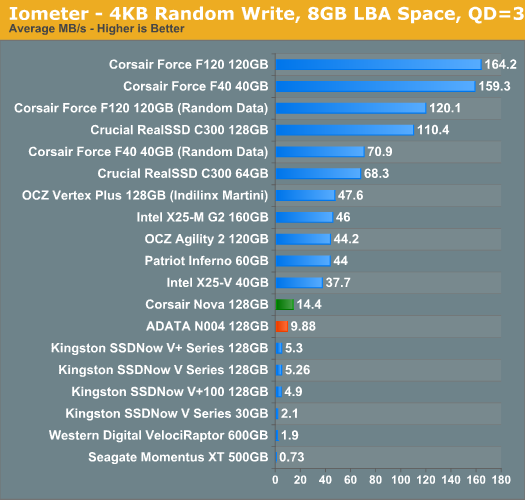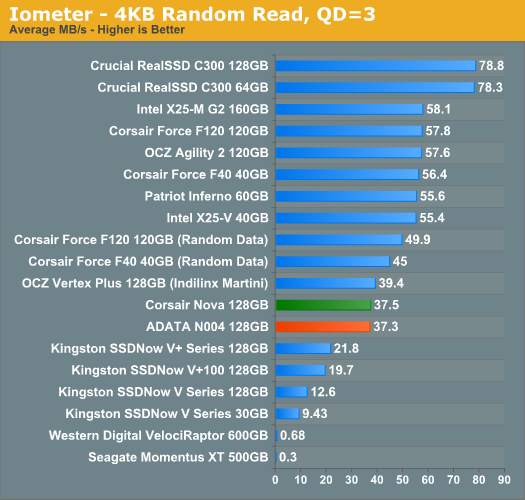ADATA N004 - SATA & USB 3.0 SSD Reviewed
by Rajinder Gill on November 29, 2010 12:38 PM ESTThe four corners of SSD performance are as follows: random read, random write, sequential read and sequential write speed. Random accesses are generally small in size, while sequential accesses tend to be larger and thus we have the four Iometer tests we use in all of our reviews.
Our first test writes 4KB in a completely random pattern over an 8GB space of the drive to simulate the sort of random access that you'd see on an OS drive (even this is more stressful than a normal desktop user would see). As we've explained in the comments in previous reviews, simulating the type of random access you see in a desktop workload is difficult to do. Small file desktop accesses aren't usually sequential but they're not fully random either. By limiting the LBA space to 8GB we somewhat simulate a constrained random access pattern, but again it's still more random than what you'd see on your machine. Your best bet for real world performance is to look at our Storage Bench charts near the end of the review as they accurately record and play back traces of real world workloads.
For our random access tests we perform three concurrent IOs and run the test for 3 minutes. The results reported are in average MB/s over the entire time. We use both standard pseudo randomly generated data (data is random within a write, but duplicated between writes) for each write as well as fully random data (data is random within a write and random across most writes) to show you both the maximum and minimum performance offered by SandForce based drives in these tests. The average performance of SF drives will likely be somewhere in between the two values for each drive you see in the graphs. For an understanding of why the type of data you write to SF drives matters, read our original SandForce article.

Our random read test is similar to the random write test however we lift the 8GB LBA space restriction:

The random read/write performance is where ADATA are having to rely on the unique connectivity aspect of the N004 as a selling point, because the Inidilinx Barefoot doesn't do well against drives with better controllers.










16 Comments
View All Comments
SteelCity1981 - Monday, November 29, 2010 - link
You'd think that paying that much for a 128gb SSD portable USB 3.0 hard drive would at the very least include frimware updates. I mean, this isn't some random 45 dollar HDD 120gb Portable USB 2.0 hard drive we are talking about here.StormyParis - Monday, November 29, 2010 - link
thoughput and latency are fine and all, but in my experience USB is mainly about very sucky CPU usage.a test on that front, with various chipsets, would be faaaaaabulous.
jaydee - Monday, November 29, 2010 - link
I'd be interested in seeing some numbers using eSata via an external enclosure.StormyParis - Monday, November 29, 2010 - link
any SSD can do that, and the results will be the same as an internal one.Qapa - Monday, November 29, 2010 - link
1 - Probably the most important one: when are we going to see the promised price cuts due to the move to lower nm? It was supposed to be this quarter right...?2 - When is the Jet Stream now supposed to come out?
3 - I read somewhere that Intel G3 was put on hold due to the presentation of SandForce 2000 series?
4 - When is this SandForce 2000 series expected to come out?
I want a new generation SSD with 64Gb @ around $64!! (yes, this one is not really a question.. :P)
mpx - Tuesday, November 30, 2010 - link
It would be interesting to find out how well such USB 3 SSDs perform as ReadyBoost caches. Or caches with other products - NVELO Dataplex, eBoostr.